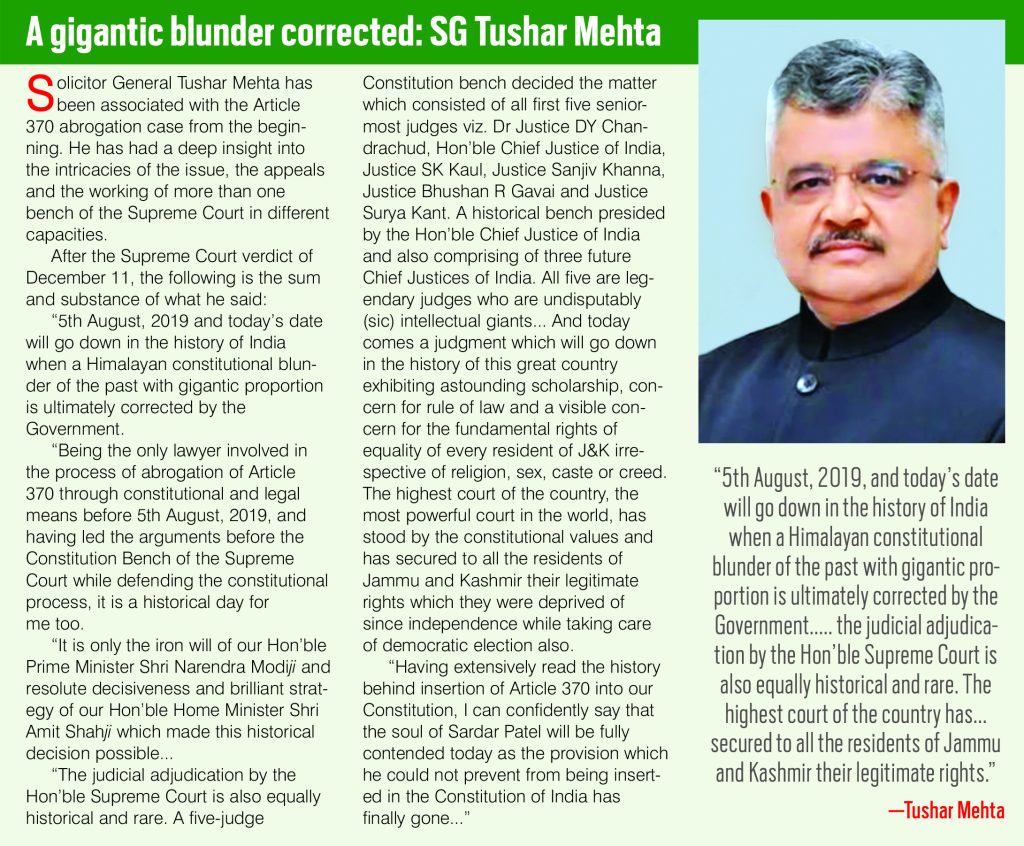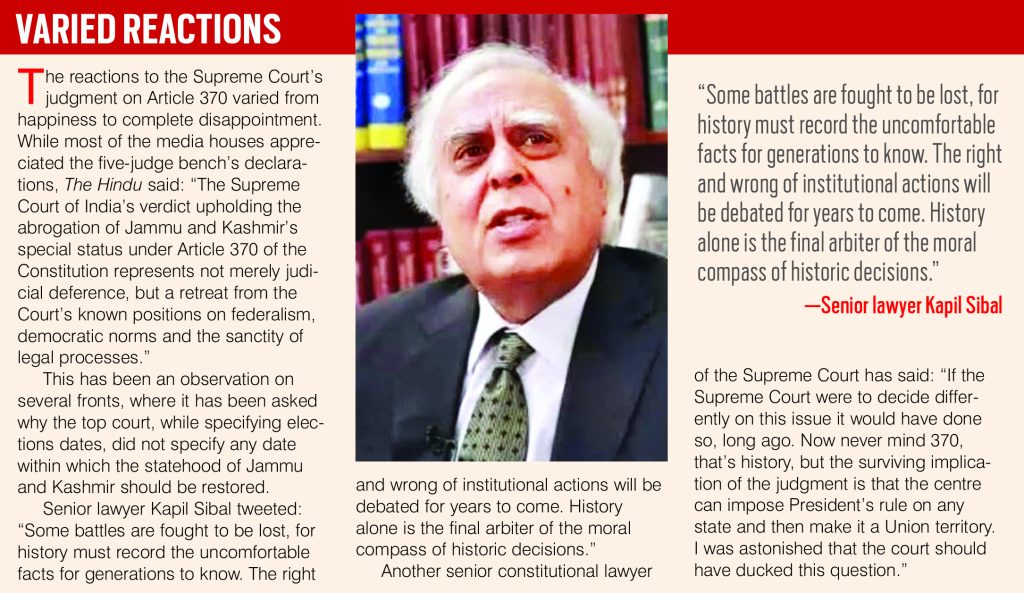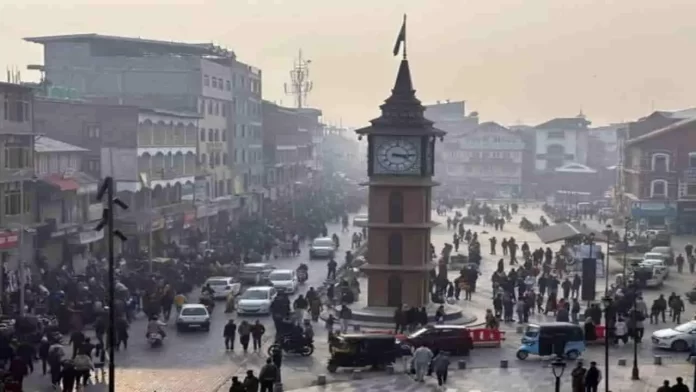The people of the Kashmir valley will have to accept the inevitability of the situation, for better or for worse. The uniqueness of Jammu and Kashmir has been done away with and a legal sanction has been obtained with the recent verdict of the Supreme Court. That is the final nail in the coffin
By Sujit Bhar
More than a judgment, the pronouncements of the five-judge bench of the Supreme Court, led by Chief Justice of India DY Chandrachud, can be better absorbed as a vindication of the stand of the government on the stature of Jammu and Kashmir and the status of Article 370 of the Constitution, which was abrogated through a presidential decree on August 5, 2019.
Also Read: Fali Nariman on the Article 370 verdict
The process was as follows: President Ram Nath Kovind’s Constitutional Orders 272 and 273 “during the subsistence of a Proclamation under Article 356(1)(b)” [NOTE: quoted from judgment], had the effect of “applying the entire Constitution of India to the State of Jammu and Kashmir and abrogating Article 370”. At the same time, “Parliament enacted the Jammu and Kashmir Reorganisation Act, 2019, which bifurcated the State into two Union territories”.

The constitutionality of these acts was what the petitioners had challenged before the apex court. The Court said in its December 11 verdict that there was no need to consult the constituent assembly of the state—this was, anyway, dissolved in 1957—and that Article 370 was a temporary provision. The Court has directed the Election Commission of India to conduct elections in Jammu and Kashmir by September 30, 2024, and has asked the centre to restore its statehood.
The bench, which also comprised Justices Sanjay Kishan Kaul, Sanjiv Khanna, BR Gavai and Surya Kant, went through the appeals before it and ruled that Jammu and Kashmir did not enjoy sovereignty under Article 370, but that was a feature of asymmetric federalism. The Court had reserved its judgment on September 5.

The Court also upheld the carving of the Union Territory of Ladakh from the erstwhile state. The petitioners had also challenged the J&K Reorganisation Act, which bifurcated the erstwhile state into two Union Territories—Jammu and Kashmir and Ladakh. The Constitution bench heard the matter for 16 days, from August 2.
Some special observations
The Court observed the following about the marginal note to Article 370 (and quoting from the judgment):
“Since the Maharaja (Hari Singh) or his successors did not sign a merger agreement with the Union of India, the State retained residual sovereignty and Article 370 was incorporated in the Indian Constitution as a recognition of the same. The reason for placing Article 370 in Part XXI of the Constitution of India was that the Constituent Assembly of India assumed that as and when the Constituent Assembly of the State will be established, it would recommend the abrogation of Article 370, and thereby fully integrate the state into the Union. It cannot be said that by reason of being placed in Chapter XXI of the Constitution of India, Article 370 could have been abrogated at any time by the President.
“This is apparent also from the fact that the provision was kept out of the purview of Article 368 of the Constitution, and a mechanism for its abrogation was provided in Article 370(3). Thus, it was temporary only insofar as the Constituent Assembly was not in place at the time of its incorporation into the Indian Constitution. It was a permanent provision of the Indian Constitution notwithstanding its placement in Chapter XXI of the Constitution and the state was to be governed by two Constitutions; and the word ‘temporary’ in the marginal note, does not refer to the limited duration of time, after which the Article would cease to exist. It implies that unless the specific conditions of its repeal, that is, convening of the Constituent Assembly of the State of Jammu and Kashmir cannot be secured, the Article will continue to operate irrespective of the duration of time.”

The five-judge Supreme Court bench observed: “Article 370 could only have been repealed by the Constituent Assembly between 1950 and 1957. After that, that is after the Constituent Assembly of the State ceased to exist, it can only be amended by way of the procedure specified under Article 368, followed by its extension to the State of Jammu and Kashmir by Article 370(1)(d).”
The takeaways
The critical takeaways of the judgement have been the following:
- Article 370 is finally a thing of the past, and though former J&K chief minister Omar Abdullah says that like in the previous top court three-judge bench’s acceptance of the petitioners’ demands, a future bench could alter this bench’s decree, that is a long shot in the windy outdoors.
- Even Dr Karan Singh, the son of former J&K King Hari Singh (who agreed to accede to India) has said: “I am aware that there will be sections in the state that will not be happy with the judgment. My sincere advice to them is that they should accept the reality and move on and turn their energies towards elections that are now due…”
- Two epochs have now been formally created—one during Article 370 and one after the abrogation of Article 370. The Supreme Court judgment, through an analysis of the happenings of the past, has assured that.
- The people of Kashmir now have a fait accompli handed to them. Their future, therefore, has been a political decision of the Union, backed by a judicial decision of the Supreme Court.
In short, the people of the valley will have to accept the inevitability of the situation, for better or for worse. The uniqueness of Jammu and Kashmir has been done away with and a legal sanction has been obtained. That is the final nail in the coffin.
It is possible that such actions could be used in the bifurcation of other states as well, but that would be another political decision, imposed on another state from the centre, a power that a representative democracy gives the elected representatives in parliament.
Till such time, this remains an active template.


